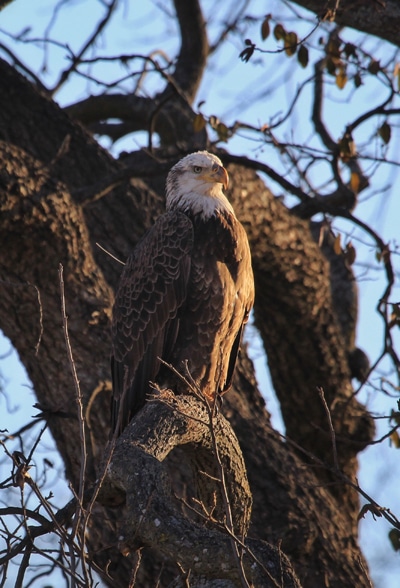February’s article for the aviary didn’t contain a great deal of information about Wadasé Zhabwé other than a brief description of her recent telemetry location and movements. We knew that would often be the case as she visits the aviary less frequently. While we were happy to report that she was doing well according to that data, we couldn’t help but wish that we had more to share. The GPS data certainly is reassuring and is an incredibly valuable tool to monitor her progress but nothing compares to observing her with our own eyes.
The weather here has been relatively mild for this time of year and we hoped to do some fieldwork while it remained favorable. We still needed to check on the bald eagle nest we monitor in the northeastern portion of the state as well as scout an area to the northwest of the aviary near Horseshoe Lake in Harrah where Wadasé continues to spend most of her time. After checking the extended forecast, we worked out a schedule to go out on the warmer days when we didn’t have tours scheduled. Jan. 16 was the first date we scheduled. The evening before, we packed lunch and loaded everything in the truck. We were all set to leave the following morning but even the best laid plans don’t always work out the way you had hoped. Sometimes they work out better. 
Just after we finished breakfast, the eagles all began to vocalize. We headed towards the aviary, to see what had everyone stirred up so early, just in time to see Wadasé flying just inches above the enclosure before she landed on her crook out front. The last time she was at the aviary was Nov. 10, 2015. So all of our plans for this particular Saturday would just have to wait. We weren’t going anywhere once she arrived and it isn’t polite to ignore your guest! We spent the better part of the morning watching her from the office window. As hard as it is, we try and give her space the first day she visits the aviary, limiting photographs from the office windows and keeping the grounds quiet as possible during the mornings.
While we will never know how long she intends to stay or what makes her come back, we can only rely on what we have done in the past. So far that balance seems to work.
She spent the better part of the day in her favorite crook in the pecan tree out in front of the aviary, taking short flights around the pasture to the aviary and back to her perch. She even brought her own lunch back to her crook to eat. At dusk she headed towards the river. The next morning we were in the office by 6:30 a.m. hoping she would spend another day at the aviary. When we finally decided to reload the truck, she came flying in at 7:40 a.m. just as the sunlight reached her perch. She sat there soaking up the warm morning sun for several hours. Sometime after 2 p.m. that day she left. She was perched out front and then she wasn’t.
After checking telemetry we know she returned to the area around Horseshoe Lake. We still have a visit scheduled to the area if Wadasé doesn’t change those plans first.
As always we encourage you to keep your eyes out for Wadasé if you are near the areas she frequents. To follow her movements with us you can visit www.arcgis.com/home and search for “Potawatomi eagle.” Send your encounters with Wadasé or any other eagles in Oklahoma or wherever you may to the CPN Aviary at aviary@potawatomi.org. For more information about Wadasé or the CPN Aviary visit www.potawatomiheritage.org/#aviary
